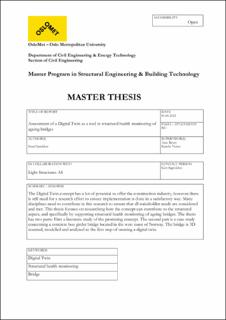Assessment of a digital twin as a tool in structural health monitoring of aeging bridges
Master thesis
Published version
Permanent lenke
https://hdl.handle.net/11250/3023197Utgivelsesdato
2022Metadata
Vis full innførselSamlinger
Sammendrag
The need to travel from one place to another is a fundamental pillar of our society. Since the beginning of time, humans have altered their surroundings to get from A to B in a more efficient way. Often, this pursuit of accessibility would involve the great challenge of building a bridge. Even today this is seen as a challenging task, due to factors such as ever-increasing traffic loads, lack of resources and climate change. The latter is also an important reason for the need to maintain existing bridges instead of demolishing them, which would cause large CO2 emissions.
Recently a new concept has grown in popularity within the construction industry; Digital Twin, which offers a new level of control over our assets. The Digital Twin concept offers the possibility of updating the digital model by IoT technology as well as simulation of what-if-scenarios. For a bridge, the positive outcomes of having a digital twin can be increased safety, decrease in maintenance cost and extended service life.
Osstrupen Bridge, a prestressed box Girder Bridge that has been strengthened by an internal tubular arch due to an excessive sag is studied in the context of the Digital Twin concept. The mounted support system within the bridges cavity is equipped with sensors. By utilizing these sensors, a step in the direction of a digital twin for the structure can be made.
